_I asked Cat where she wanted to have our anniversary dinner and she said she'd been craving Japanese. And when it comes to Japanese food, Hanakazu will always be among the first restaurants I'll think of.
This traditional Japanese restaurant along Aguirre (near the Elizalde stoplight) -- now entering its seventh year of business -- is helmed by none other than the former chef of the posh Tsukiji restaurant in Makati, Hiroaki Otsuka. If you're a fan of Japanese food you'll already know what that means; if not, then let us quote you what they've put at the front page of their menu: "Fresh Sushi. Delectable sashimi. Crispy tempura. Tender Beef Sukiyaki. Mouth-watering Ebi Ten Maki." The descriptions do not exaggerate. From a small restaurant, Hanakazu has expanded its space to accommodate its growing clientele, a testament to Chef Otsuka's labor of love.
We ordered a perennial favorite, the Ebi Ten Maki, a sushi roll tenderly cradling crisp ebi tempura slices in its center; Miso Soup; a refreshing Kani Salad; Yakiniku (grilled beef); and Yakimeshi (fried rice).
All the dishes were made to the high standard that this popular restaurant has come to be known for -- all the ingredients are top-grade and fresh, the flavors light and ethereal, very well balanced -- you can see the chef's expertise in the way every roll of sushi here is rolled just so, the sashimi cut so neatly you'd swear fish grow in neat rectangles and lozenges.
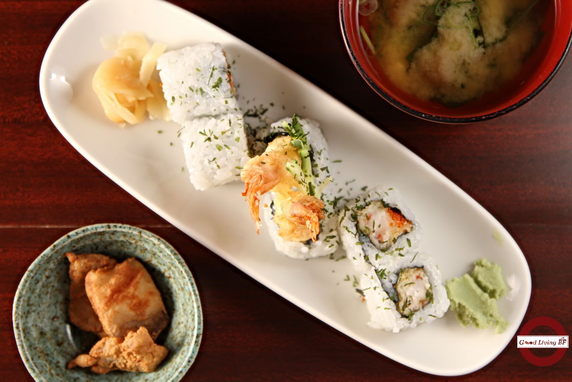 Ebi Ten Maki with Maguro Tatsutaage and Miso soup _As I said, we nearly always order the Ebi Ten Maki when we eat here; Hiroaki's wife Lorna says she's not sure whether this roll is Hiroaki's own invention or not, but she does get comments from foodies telling her Hanakazu's version is the best they've had. I agree. We also received tiny bowls of Maguro Tatsutaage, breaded tuna slices fried crisp, as a complementary appetizer.
A new revelation for us was the Kani Salad, a beautiful light salad of lettuce and assorted greens, carrots, and kani strips, tossed in a light semi-sweet mayo dressing and topped with strips of dried seaweed. The serving of this salad was surprisingly large, easily good for sharing among three or four. On its own, it can make a pretty filling meal for a health-conscious diner. We also loved our Yakiniku, the beef so tender we could tear apart the strips easily with our chopsticks, with a light soy-pepper-slightly-sweet flavor. The beef went perfectly with our sticky Yakimeshi.
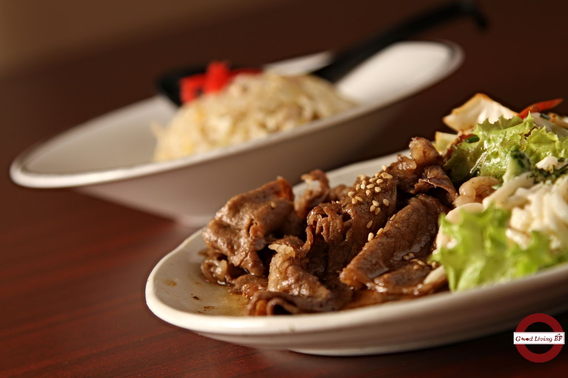 Yakiniku with Yakimeshi  Kani Salad _Chef Hiroaki was too busy to interrupt, but we were able to get Lorna Otsuka to drop by our tatami room and tell us more about Hanakazu. The restaurant's name is taken from their daughters, Hana and Kazuko. They and their two sons, Yoshi and Sachi (after whom the two tatami rooms are named), are the reason Chef Hiroaki is happy in BF Homes rather than taking up offers to open a Hanakazu branch in commercial districts like Makati. "We were tempted by an offer when Serendra was new, but when we found that we'd have to be open all week, my husband said no," reveals Lorna. "He wants his Mondays off, because that's his day to be with his children. That's the day he'll make them lunch himself as a treat."
The rest of the week, though, is spent keeping up the quality that Hanakazu's become known for. Though the restaurant opens at 11:30 a.m., Hiroaki arrives early to begin making the ramen broth, which he insists on making fresh every day. He also does the marketing for ingredients himself every three days, and they regularly receive shipments of locally hard-to-find items from Japan.
That passionate attention to detail is evident in every bite here at Hanakazu, which is why we've been regular customers since 2005. The staff even remembers my friends and I as "that noisy gang that always makes such a ruckus in the tatami room but orders a lot!", said with a smile, of course. Lorna said that their loyal customers now have "Hanakazu babies" -- you could say that we could count ourselves among them as well.
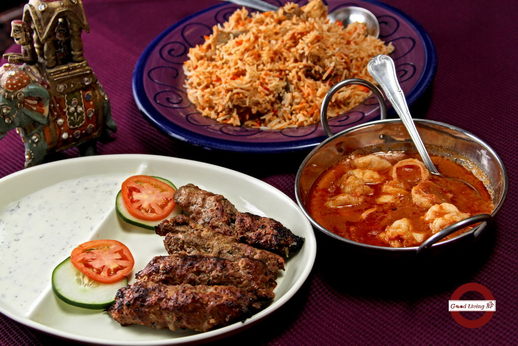 Beef Kababs, Chicken Biryani, Prawn Curry
When I was fifteen and living in New Delhi with my parents, I'd often get off the schoolbus a few blocks before our street and walk home from there so I could pass by the local bakery. I'd pick up half a dozen piping-hot vegetable samosas, make half of them disappear, and arrive home with a cheery 'Hey Mom, Dad, look! I got us samosas -- one each!'
My first bite of Raaz Mahal's vegetable samosas inevitably brought back this memory, as fresh and sharp as it was yesterday (Hey, it's not been that long ago! Uh, yeah riiiight.). I guess another reason this memory got triggered was because our first visit to Raaz Mahal was at my dad's invitation, his treat for me on my birthday. The two of us have had a real weakness for Indian cuisine ever since that stint in Delhi, and as Raaz Mahal serves Punjabi food, the same North Indian food we got used to, we're really happy we've now got a restaurant like this in BF. A few days later, Cat and I visited again to interview the Arshad family, Raaz Mahal's owners, and of course to eat more samosas.
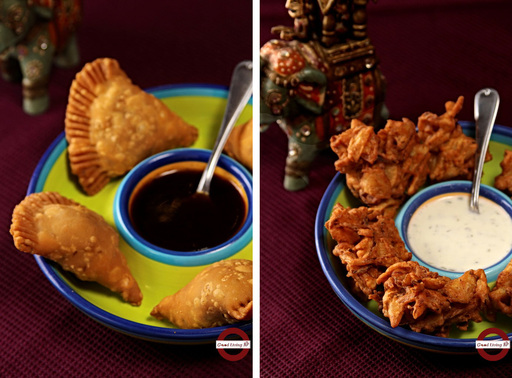 Vegetable Samosas and Potato Pakoras Ordering for the family, I went for the tried and true appetizers: Vegetable Samosas, Onion and Potato Pakoras, and cheese-filled Aloo (Potato) Balls. We followed this up with the Chicken Dal, Chapatti bread to scoop up the dal with, Beef Kababs, Prawn Curry, and Chicken Biryani, and on our return visit, we tried the Goat Korma and Naan.
The great delight of Indian food, for me, is the way the complex blend of spices, the masalas, create a cascading explosion of flavors on the palate and the nose. This is exactly what we got with Raaz Mahal's food. The Samosas were crisp on the outside, soft and delicately spiced inside, and served with a sweet and tangy chutney sauce. The Pakoras were also crisp, really nicely done -- flavorful, not oily at all despite their being deep-fried -- and went great with the provided chili dip. The kids went bananas over the Aloo Balls, which were like potato croquettes filled with an herbed cottage cheese, and also served with chili dip.
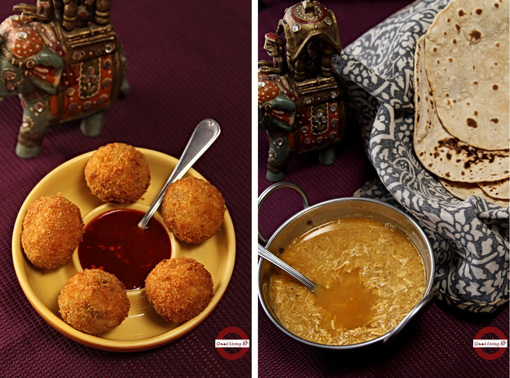 Aloo Balls and Chicken Dal with Chapatti
I would've liked more lentils in the Chicken Dal, which was a lentil-and-chicken stew with curry spices. You scoop it up with torn pieces of Chapatti bread or Naan. The Beef Kababs and Prawn Curry came next, and disappeared very quickly! The kababs were delicately spiced, still moist inside (ground meat kababs dry easily, so this tells me the cook has a light hand on the grill), and served with a yogurt-mint-and-coriander-leaf sauce that surprisingly turned out to be the spiciest thing on the table, heat-wise. The Prawn Curry was buttery and had just the right amount of heat for the family -- strong enough that you could tell this was real Indian food, yet toned to the level that my sister and nieces could still taste everything. And the prawns were very fresh -- they had that sweet fresh taste. Because of the strong sauce of the kabab and the prawn curry, I'm afraid I wasn't able to really isolate the flavor of the biryani very well; it was very fragrant though, and yes, it was made with real basmati rice.
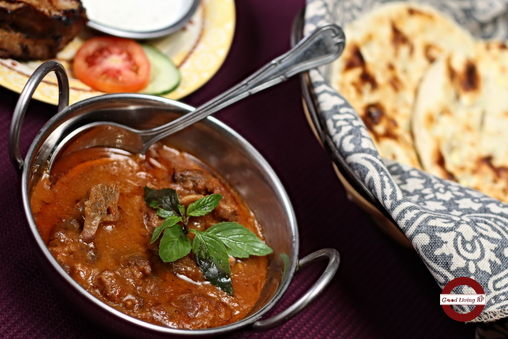 Goat Korma with Naan I wish though that I'd thought to order the Korma while my whole family was there. That was a knockout! The yogurt-based sauce was very rich and creamy, nicely aromatic with the distinct yet far from overpowering mutton scent that tells you this isn't beef or pork. (Raaz Mahal is owned by a Pakistani family and serves Halal food). If I had to recommend a dish with which to break the common Pinoy aversion to goat or mutton, this korma would be high on the list, if not first. We chose to have this curry with Naan bread instead of rice, and I'm happy to report that Raaz Mahal's naan is the kind made with sesame seeds, giving them a nice added crunch.
I just wish the portions were bigger, a concern that manager Shala Arshad assures me will be dealt with when they come out with their new menu. Now that they know their market and are more confident that their food sells, Shala says, they're ready to upgrade the 'sampler' portions to something larger. Raaz Mahal is not a cheap place to eat, but given the complexity of their dishes, and the fact that all the spices they use must be imported from Pakistan, you know what you're buying.
Shala, her brother Ismail (Ish), the chef, and their father Muhammad sat with us as we were wolfing down the korma to tell us Raaz Mahal's story. The name Raaz Mahal means 'Secret Palace' or 'Mysterious Palace,' and fits right in with the tasteful, very Indian theme of the interiors. The Arshads own the Orientique furniture and antiques stores, and it shows. Raaz Mahal's interiors are painted in the gay hues of a bazaar in Rajasthan, and studded with plaques and statuettes done in traditional Indo-Persian motifs.
Nor are the Arshads newbies at the restaurant business, having opened one in Jakarta sixteen years ago, and another in Lahore. In fact, Shala says, the very reason for Raaz Mahal's existence is the love she and Ish have for their dad's cooking, which is based on traditional Muslim Punjabi recipes. But when he finally caved in to their insistent clamor for a restaurant here in Manila, it was Muhammad Arshad who chose Aguirre Avenue as their first location; a tribute to the burgeoning BF Homes food culture.
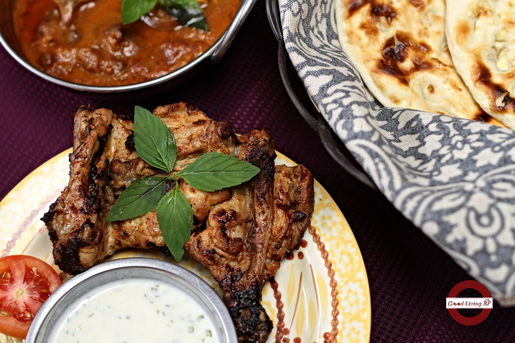 Chicken Tikka
We finished our meal the same way we did on the previous visit, with a Strawberry Lassi. This sweet iced drink, with just the right amount of fresh strawberry and yogurt tartness, clears the palate beautifully after a meal rich in heady masalas and ghee; not surprisingly it's one of their bestsellers. They also offer Mango and Banana Lassi, and we also tried their Kulfi; an ice-cream like dessert made with milk steeped with intoxicatingly fragrant cardamom and topped with crushed pistachios. Dairy-based desserts are very important when you eat hot food like Indian or Malay, as the milk clears the burning sensation from the tongue. (Alcohol intensifies it though; which is why, spice freak that I am, I had my appetizers and main course with San Mig Lite!).
Ish Arshad says, though, that we've yet to try their real signature dish, the Beef Nihari. It's a rich beef curry that takes all of seven hours to cook, and I can just imagine how richly developed its flavors should be from that treatment. Looks like Cat and I have something to look forward to!
 The Arshad Family
 Lamb satay There's a place in BF that serves lamb satay! Whee! That was my first reaction on reading the menu at Food de Sentosa, a Singaporean restaurant in Phase 3 that's been garnering quite a bit of attention lately. Business has been good so they are expanding the restaurant and adding five to six more tables next month.
Food de Sentosa is owned by Mr. Ronnie Teo, a Singaporean who's immigrated and married here. His son, David, turned out to be a co-teacher of mine at the College of Saint Benilde, but had to take a leave to help out at the restaurant due to the unexpected boom of demand there. He is now its full-time manager but you can also find him inside the kitchen helping his dad cook.
The elder Teo is a retiree who started the restaurant simply because he got bored after retirement. He had always loved cooking as a hobby and being the cook of the family, he brought in his family recipes as well as his own style of cooking and drew from Singapore's mixed Malay-Chinese heritage to build up Food de Sentosa's menu.
The eventual success of Food de Sentosa is one of life's quirks that just happens: With no business plan, no formal culinary training, no background in the food business, but armed only with a love of food and cooking, he launched his restaurant in November 2009. He never expected it would take off the way it has--they were even featured in the Philippine Daily Inquirer without their knowing a reviewer had visited--because he wasn't serious about it when he started, recalls David.
Today, they have regulars in and out of BF, like a fellow Singpaporean who travels all the way from Batangas just to eat there three to five times a week. Can you say Food de Sentosa addict?
One other reason for his success may be that Mr. Teo simply can't say no to any customer requests--he once cooked tempura for a customer. "Sometimes, he will cook something new on the spot and sometimes the dish would find its way to the menu the next day," David grins. He will also create new dishes with in-season ingredients like tom yao, kay lan, bok choy, and tang-o either from the local market or flown in from Singapore. (They also have kid-friendly dishes like Fried Fish Fillet with Chili Crab Sauce that's not spicy and custom-made prawn-flavored fried chicken).
 Nasi Goreng Cathy and I decided to try out the Lamb Satay -- hey, I never say no to lamb satay! -- the Black Pepper Beef, and the Nasi Goreng.
We loved the Lamb Satay, grilled to tender perfection and served with Mr. Teo's own traditional peanut sauce. Food de Sentosa's version of satay sauce is not as sweet as the Madurese version served in Pawon Ageng; I think it has more tamarind, and has a more herby aroma. Which do I like better? Give me both! Nobody ever died of a satay overdose, and one of these days when wifey is not watching I'm going to prove it! The sauce went very well with the unique aroma of lamb.
The Black Pepper Beef had a nice savory flavor, though not as hot as I would've expected from a Singaporean restaurant; unfortunately there were some tough bits.
I enjoyed the Nasi Goreng, Malay-style spiced fried rice with bits of meat, vegetables and egg, made savory with belachan, Malay dried shrimp. I rather wish the portion was a bit larger because we finished it before we could consume all the beef. The Nasi Goreng was really a meal in itself--a scrumptious one at that--so we could've gotten two and skipped the Black Pepper Beef.
I also wish I wasn't allergic to crab. A serving of chili crab went to the other table just as Cat and I finished eating, and the aroma simply grabbed me and almost made me forget I'd already eaten.
I've always said BF Homes needs more restaurants like these, and I'll say it again. Singaporean food is a great way for Pinoys to start sampling the wider galaxy of Asian cuisines, blending as it does the influences of Malaysian and Indian cuisine with the familiarity of Chinese, and Food de Sentosa is just the place for it.
One last detail: Why the color purple as the restaurant's theme color, we asked David. Because his dad didn't want the all-too familiar red, David laughs. Food de Sentosa's striking color was a great way to announce itself to the community a year-and-a-half ago, being the first restaurant here to use it in a big way. Today, his cooking and can-do attitude has endeared himself to his customers and has established his former hobby into a full-blown business.
High concept modernity and the homey familiarity of Filipino comfort food rarely feel they belong together. At Big Plate restaurant, however, they've made it work. From the tasty fusion approach they've taken with old Pinoy favorites to their chic but comfy interiors and the way they're recycling energy from their aircon to heat water, this is one restaurant that's serious about bringing the Filipino dining experience into the 21st century. They’ve even invested in their own organic farm and commissary, on top of state-of-the art technology for their kitchen. All of these serves as a foundation for a restaurant the owners hope will become part of the Filipino tradition.
So how successful are they? Only time will tell but they certainly are off to a good start. Just in the midst of their soft opening, phase, they have already attracted a steady crowd. Why?
Let's start with the ambiance. Yeah, I know you never order it, but you pay for it anyway -- and it really does affect the pleasure of eating. There's a clean, casual, modern-but-organic feel to Big Plate's interior with its mostly green and white scheme, accented by colorful Maranaw vinta themes on its quirky furniture , runners, and its walls. There's a very family-friendly vibe to the place. The tables are also big -- as CEO Rainier David says, they designed the place so that a table normally used for six people at other restaurants is made to seat four here. Which turned out to be very good, as when the food arrived the restaurant's name was proven to be no lie!
Yes, Big Plate really serves BIG plates. With servings to match -- big connotes a feast , hence the name Big Plate, David explains. The typical order here is good for two, easily three if you're light eaters. We got to sample some of their best sellers: For starters we had the Creamy Pumpkin Soup, Bangus Sisig Balls, Lumpiang Dagupan, and Big Plate's House Salad with beef tapa. For our main course David had us try the Crispy Binagoongan, Grilled Prawns with Bagoong Rice, and the Slow-Cooked Beef Ribs with Sweet Potato. And for dessert, it was their two most popular meal-toppers, the killer Coco Mango Panna Cotta and Carrot Cake. Visually, these dishes were a breeze to shoot - they all looked good, and they smelled so good it was easy to get inspired! Amount-wise, we were totally overwhelmed. Immobilized afterward was more like it.
For starters, we had the Creamy Pumpkin Soup. Squash soup is one of my favourite soups, something I always ask Cat to make at home. Although we have it every now and then, I have never tasted it with eggplant so Big Plate’s version comes as a refreshing change, the smokey flavour of the roasted eggplant adding lushness to the pureed soup.
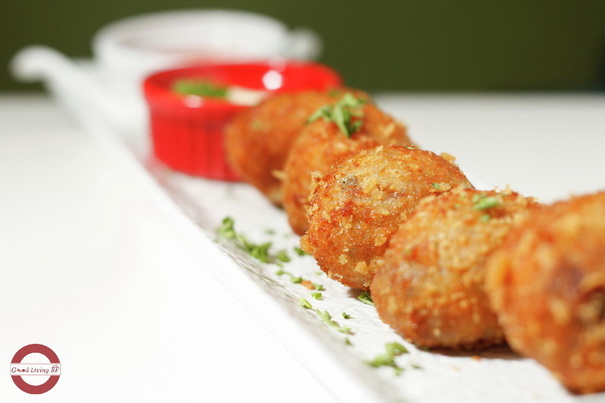 Bangus Sisig Balls We've had the Bangus Sisig Balls twice already, and we'll probably have it every time we visit Big Plate. These are fried croquettes filled with tinapang bangus flakes, served with aioli and sweet and sour sauce on the side; I prefer it with the aioli. The Lumpiang Dagupan, as you might expect, are also filled with bangus, very light and crispy.
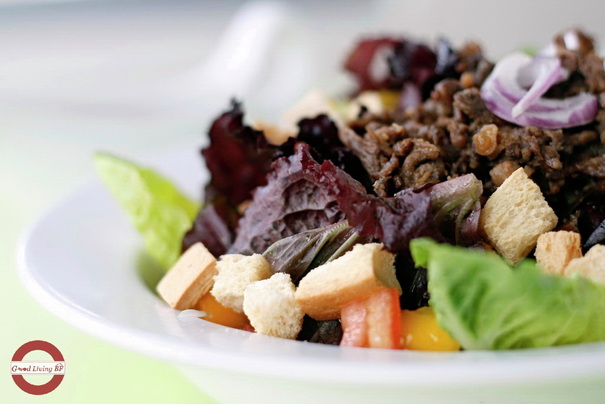 Big Plate House Salad Cat and I also loved the Big Plate House Salad, a green salad jazzed up in a uniquely Filipino way by the inclusion of homemade beef tapa bits and mango cubes. The sour-salty-meaty taste of the tapa made a great counterpoint to the sweetness of the mango and really set off the greens well, and for this diehard carnivore, it's a great way to make me eat and enjoy my veggies.
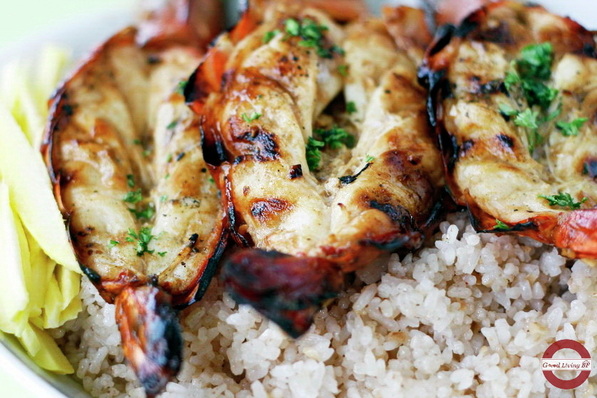 Grilled Prawns with Bagoong Rice Next up were the Grilled Prawns; fresh, fleshy, and full of flavor, and as David explained to us, there was no need for a sauce because the sauce was already inside. To a true Filipino there's no pleasure like sucking out the juicy insides of a prawn head, and the heads of these prawns were especially flavorful. Unfortunately this Pinoy is asthmatic and allergic to crustaceans, so I only had the courage to try one head. It was so good!
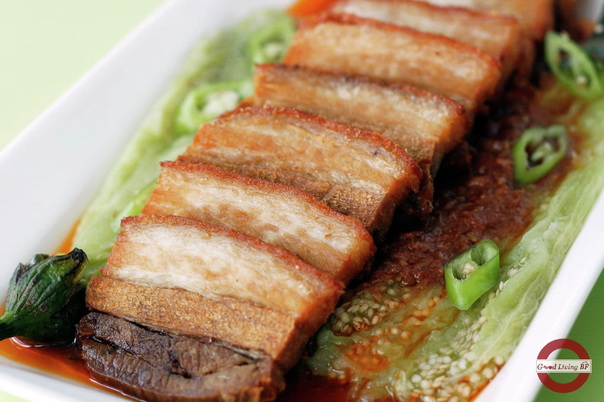 Crispy Binagoongan Another sinfully delicious treat was the Crispy Binagoongan, crisp-fried slices of pork liempo on a bed of bagoong sauce and eggplant. Unlike many a binagoongan dish we have eaten, this had a light hand with salt -- in fact, this can be said for all the dishes we tried -- so I didn’t mind chewing and crunching the meat even though it was unfortunately fried a little too long. Still, Cat said she liked this version a lot and thinks it’s a better alternative to the salt-drenched, sweat-inducing binagoongan dishes we usually encounter.
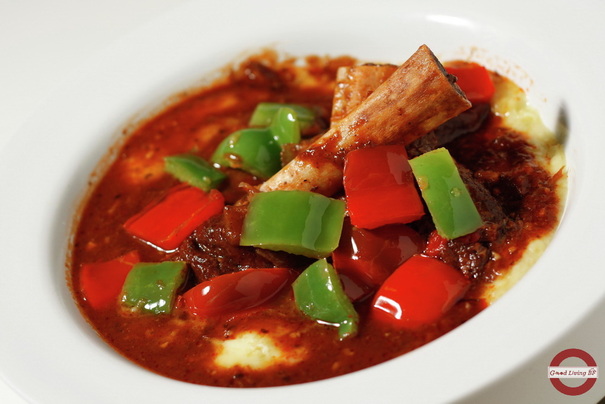 Slow-Cooked Beef Ribs with Sweet Potato The entree I got to enjoy the most was the Slow-Cooked Beef Ribs with Sweet Potato; a very rich take on kaldereta, with a thick sauce made even richer by the scoops of buttery mashed sweet potato floating in it. This dish was a must-have in my mind as soon as I saw it on the menu, as I like the full flavour and tenderness of slow-cooked meat; Big Plate did not disappoint, as I got the beef falling off the bone and so tasty I would've gnawed the ribs afterward if my wife hadn't stopped me! It was no surprise to learn that this is one of their bestsellers.
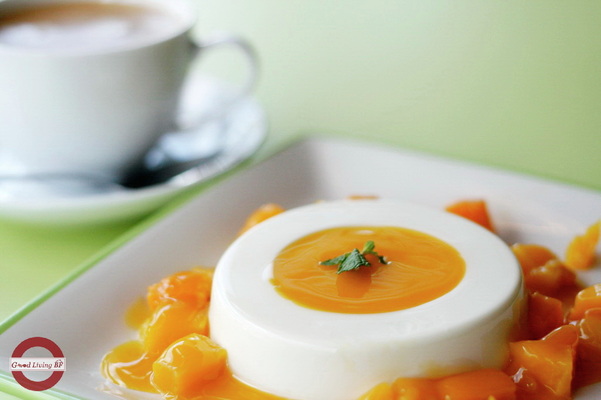 Coco Mango Panna Cotta For dessert, we tried the Coco Mango Panna Cotta and Carrot Cake. The panna cotta -- another bestseller -- is again one of Big Plate's very successful Filipinizations of an international dish, as they substitute coconut milk for dairy cream in it. The fragrant nuttiness of the coconut milk perfectly complemented the sweetness of the mango topping. This is one dessert that manages to be rich and refreshing at the same time, a difficult combination to achieve.
 Carrot Cake Finally, after almost having our fill of all of the above, we ended with the Carrot Cake. Finished it. ‘Nuf said.
There's also something for the kids, David points out: Spaglug, which as the name suggests, is a mix of spaghetti and pancit luglug. Hmmm, Filipino fusion, indeed. Then there's the Big Plate Burger; Big Plate's Tasty Fried Chicken, and the Creamy Adobo Pasta.
Big Plate enjoys a strategic location along President's Avenue at the corner of Elizalde, by the old Caltex station. It's one of the most conspicuous dining places you'll see on your way in if you're coming from Sucat Road, and thanks to its being right beside the station, it has ample parking. Big Plate is seriously targeting the events market, so it’s made its facilities to match. The second floor can comfortably seat one hundred plus another forty on the verandah, and there’s a small function room that can seat thirty with a seminar-type layout.
Best of all, I may be able to eat at Big Plate even in Makati or the Ortigas area soon, as this restaurant is branching out in 2011. CEO David says he and his partners plan to grow this concept into a chain by next year, with the BF Homes branch serving as headquarters and training ground for future staff. Currently they have a preferential hiring policy, giving back to the community by giving priority to hiring BF residents. In other words, eating at Big Plate helps give your fellow BF Homers jobs!
Watch out for their grand opening on November 27!
|













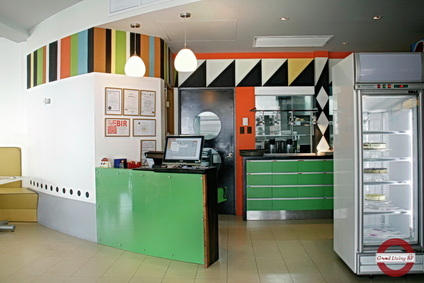
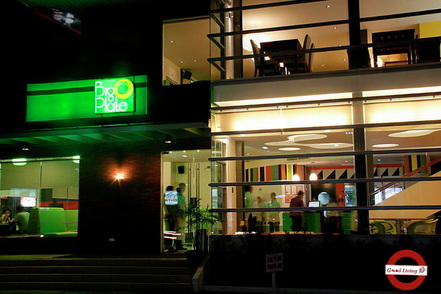







 RSS Feed
RSS Feed